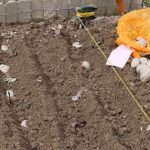Interested in growing Indian vegetables but don’t have a large outdoor space? Square foot gardening might just be the solution you’re looking for. This method, which focuses on maximizing space and productivity in a small area, is perfect for urban gardeners or beginners looking to dip their toes into gardening. By utilizing limited space efficiently, you can enjoy a bountiful harvest of delicious Indian vegetables right at home.
Square foot gardening offers numerous benefits for those interested in growing Indian vegetables. Not only does it make efficient use of space, but it also requires less water and maintenance compared to traditional gardening methods. This makes it an ideal option for busy individuals who still want to enjoy the satisfaction of growing their own produce. In addition, square foot gardening can be easily customized to suit your preferences and the specific needs of Indian vegetables.
When starting your square foot garden for growing Indian vegetables, selecting the right location is crucial. Whether you choose a sunny spot on your balcony or a corner of your backyard, make sure that your plants receive adequate sunlight throughout the day. By carefully considering factors like sunlight exposure and soil quality, you can create an optimal environment for your Indian vegetable garden to thrive.
Benefits of Square Foot Gardening for Growing Indian Vegetables
Square foot gardening is a popular and efficient method for growing vegetables, including Indian varieties. The key benefit of square foot gardening for growing Indian vegetables lies in its space-saving design. By dividing your garden into square-foot sections, this technique maximizes the use of available space, making it ideal for those with limited garden area or even those who want to garden in small urban spaces.
Here are some benefits of square foot gardening for growing Indian vegetables:
- Efficient use of space: With square foot gardening, you can grow a variety of Indian vegetables in a small area.
- Reduced water usage: The design helps conserve water by minimizing runoff and evaporation.
- Weed control: The close planting in square foot gardening helps to prevent weeds from taking over.
Additionally, the raised beds commonly used in square foot gardening provide better drainage and aeration for plant roots, promoting healthier growth for your Indian vegetable crops. This method also makes it easier to customize the soil mix for specific vegetable requirements, such as adjusting pH levels or improving nutrient content.
- Better spacing: Each square foot allows you to carefully plan and organize your plantings to maximize yields.
- Accessibility: Raised beds make it easier to tend to your plants without having to bend down or kneel on the ground.
Selecting the Right Location for Your Square Foot Garden
When starting your square foot garden for growing Indian vegetables, one of the crucial factors to consider is selecting the right location. The success of your garden largely depends on the amount of sunlight, access to water, and soil quality in that specific area.
Sunlight Requirements
Indian vegetables generally require at least 6-8 hours of sunlight daily to thrive and produce a bountiful harvest. Choose a spot in your yard or balcony that receives ample sunlight throughout the day. Without adequate sunlight, your vegetables may not grow properly or even fail to produce fruits.
Access to Water
Another important consideration when selecting a location for your square foot garden is access to water. Ensure that the chosen spot is near a water source or easily reachable with a hose for regular watering. Proper hydration is essential for healthy plant growth and development, especially for Indian vegetables that are often sensitive to fluctuations in moisture levels.
Soil Quality
Lastly, check the soil quality in the chosen location before setting up your square foot garden. Indian vegetables thrive in well-draining soil rich in organic matter. Conduct a simple soil test to determine if any amendments are necessary to improve the soil quality for optimal plant growth.
Additionally, consider using raised beds or containers with high-quality potting mix if the natural soil in your chosen location is less than ideal for growing Indian vegetables. By carefully selecting a suitable location for your square foot garden, you can create an ideal environment for cultivating healthy and vibrant Indian vegetable plants.
Choosing the Best Indian Vegetables for Square Foot Gardening
When it comes to square foot gardening with Indian vegetables, choosing the right plants plays a crucial role in the success of your garden. Not all vegetables thrive in the limited space provided by a square foot garden, so selecting crops that are well-suited for this method is essential. Here are some popular Indian vegetables that are ideal for square foot gardening:
- Okra (Bhindi): Okra is a versatile and easy-to-grow vegetable that is perfect for square foot gardening due to its vertical growth habit. Plant okra in one square per plant and provide support as it grows.
- Eggplant (Brinjal): Eggplants are another great choice for square foot gardening. They can be grown in one or four per square, depending on the variety. Choose compact eggplant varieties like ‘Black Beauty’ or ‘Little Finger’ for best results.
- Fenugreek (Methi): Fenugreek leaves are a staple in Indian cooking and can easily be grown in small squares. Sow fenugreek seeds densely in one square and harvest the leaves as needed for culinary purposes.
In addition to these vegetables, other excellent options for your square foot garden include spinach, green beans, and chili peppers. Remember to consider the mature size of each plant and plan accordingly when deciding how many to grow per square. By selecting the best Indian vegetables for square foot gardening, you can maximize your yield and enjoy a successful harvest.
Step-by-Step Guide to Setting Up Your Square Foot Garden
Square foot gardening is a popular method that allows individuals to maximize their space and grow a variety of vegetables, including Indian vegetables, in a small area. Setting up your square foot garden can seem overwhelming at first, but with the right approach, it can be an enjoyable and rewarding experience. Here is a step-by-step guide to help you set up your square foot garden for growing Indian vegetables.
Planning Your Layout
Before starting your square foot garden, it’s essential to plan out the layout of your garden beds. Decide on the size and shape of each bed based on the space available and the types of Indian vegetables you want to grow. Remember that one square foot can typically accommodate one plant, but larger plants may require more space. Consider using raised beds or containers for easier maintenance and better drainage.
Preparing the Soil
Good soil is crucial for the success of your square foot garden. Mix equal parts of compost, vermiculite, and peat moss to create a nutrient-rich soil mixture that will provide essential nutrients for your Indian vegetables to thrive. Fill each square foot section with this soil mixture, ensuring it is loose and well-draining to promote healthy root growth.
Planting Your Indian Vegetables
Once your garden beds are filled with the soil mixture, it’s time to plant your Indian vegetables. Follow spacing guidelines for each type of vegetable to ensure they have enough room to grow. Consider interplanting compatible vegetables to make the most of your space and prevent pests and diseases. Water thoroughly after planting and continue to monitor moisture levels throughout the growing season.
By following these steps, you can successfully set up your square foot garden for growing a variety of delicious Indian vegetables. With proper planning, soil preparation, and planting techniques, you’ll be on your way to enjoying a bountiful harvest right at home.
Maintaining and Watering Your Square Foot Garden for Healthy Indian Vegetables
Square foot gardening is a space-efficient gardening technique that is gaining popularity among beginners and seasoned gardeners alike. When it comes to growing Indian vegetables using the square foot gardening method, there are several benefits that make it an attractive option. One of the key advantages is that this method allows you to maximize limited space and grow a variety of Indian vegetables in a small area.
When maintaining your square foot garden for healthy Indian vegetables, it is essential to water your plants properly. Different Indian vegetables have varying water requirements, so it’s crucial to understand the needs of each plant in your garden. Overwatering can lead to root rot and other issues, while underwatering can result in stunted growth and poor fruit development.
To ensure that your Indian vegetables thrive in your square foot garden, create a watering schedule based on the specific needs of each plant. Some vegetables like tomatoes and cucumbers may require more frequent watering, especially during hot weather, while others like spinach and radishes prefer consistent moisture but can tolerate some dry spells. By paying attention to the watering needs of your plants, you can promote healthy growth and a bountiful harvest of delicious Indian vegetables.
| Indian Vegetable | Watering Needs |
|---|---|
| Tomatoes | Frequent watering, especially in hot weather |
| Cucumbers | Regular watering to keep soil consistently moist |
| Spinach | Consistent moisture; tolerant of some dry spells |
Common Pests and Diseases in Square Foot Gardening and How to Manage Them
One of the common pests that can affect your square foot garden when growing Indian vegetables is aphids. Aphids are small insects that feed on plant sap, causing leaves to curl, yellow, and eventually die. To manage aphids, you can introduce natural predators like ladybugs or lacewings to keep their population in check. Additionally, you can spray a mixture of water and dish soap on the affected plants as a natural remedy.
Another pest that may pose a threat to your Indian vegetable garden is cutworms. These pests are caterpillars that hide in the soil during the day and come out at night to feed on young seedlings, cutting them off at the base. To manage cutworms, you can create physical barriers around your plants using toilet paper rolls or cardboard collars. Removing any debris from the garden and tilling the soil can also help disrupt their life cycle.
When it comes to diseases, fungal infections like powdery mildew can affect Indian vegetables grown in a square foot garden. Powdery mildew appears as white powdery spots on leaves and stems, leading to stunted growth and reduced yield. To manage powdery mildew, make sure there is good air circulation around your plants by spacing them appropriately. You can also use neem oil or a baking soda solution as organic fungicides to treat infected plants.
| Pest/Disease | Management Strategy |
|---|---|
| Aphids | Introduce natural predators such as ladybugs or spray water and dish soap mixture |
| Cutworms | Create physical barriers around plants with toilet paper rolls or remove debris from the garden |
| Powdery Mildew | Ensure good air circulation around plants by spacing them properly; Use neem oil or baking soda solution as organic fungicides |
Harvesting Tips for a Bountiful Yield of Indian Vegetables in Your Square Foot Garden
In conclusion, harvesting your Indian vegetables from your square foot garden can be a rewarding and fulfilling experience. By following the step-by-step guide to setting up and maintaining your garden, you have put in the effort and care needed to ensure a bountiful yield. The benefits of square foot gardening for growing Indian vegetables are evident in the quality and taste of the produce you will soon enjoy.
To make the most of your harvest, it is important to harvest your Indian vegetables at the right time. By doing so, you can savor the peak flavors and nutrient content of each crop. Remember to use sharp tools to ensure clean cuts that promote plant health and vitality for future growth.
As you enjoy the fruits of your labor, consider preserving any surplus vegetables for future use. Whether you choose to freeze, pickle, or can your produce, these methods allow you to enjoy your Indian vegetables throughout the year. With proper care and attention to detail, your square foot garden can continue providing you with an abundance of fresh, homegrown delights season after season.
Frequently Asked Questions
How Many Vegetables Can You Grow Per Square Foot?
The number of vegetables you can grow per square foot varies depending on the type of vegetable and its size. Generally, smaller vegetables like carrots or radishes can be planted more densely than larger ones like tomatoes or peppers. It’s important to consider the spacing requirements for each vegetable to ensure they have enough room to grow.
How Many Okra Per Square Foot?
Okra plants require about 1 to 2 square feet of space per plant to allow them to grow and produce a good harvest. They are relatively large plants that need room to spread out their leaves and grow tall, so overcrowding can hinder their growth and productivity. Proper spacing is crucial for healthy okra plants.
How Many Napa Cabbage Per Square Foot?
Napa cabbage, also known as Chinese cabbage, typically needs around 1 square foot of space per plant for optimal growth. This leafy green vegetable forms large heads that require some room to develop fully without competition from neighboring plants. Adequate spacing ensures that each Napa cabbage plant has access to enough nutrients and sunlight for healthy growth.

If you’re looking to get into vegetable gardening, or are just looking for some tips on how to make your current garden better, then you’ve come to the right place! My name is Ethel and I have been gardening for years. In this blog, I’m going to share with you some of my best tips on how to create a successful vegetable garden.





